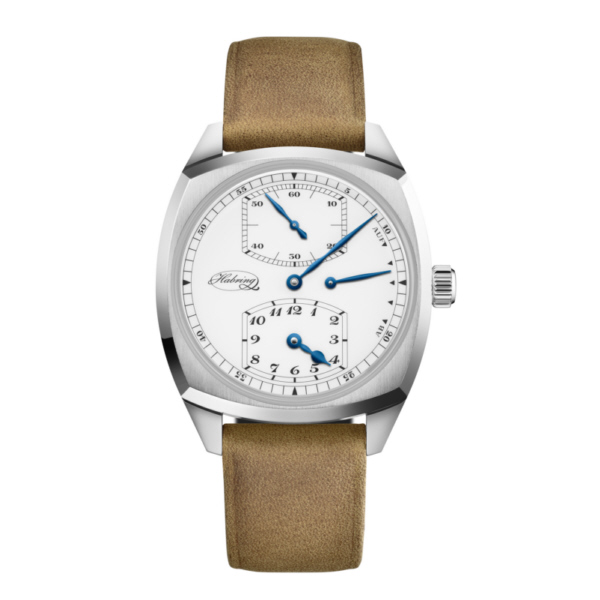HABRING Uhrentechnik OG
Possibly the smallest watch manufacturer in the world?
Certainly the only watch manufacturer in Austria! From today's viewpoint Austria is hardly renowned as watch-making country – but it was not always that way:
Maria and Richard Habring are directing their engagement towards reconnecting with the great Austrian history of watch- and clock-making that has unfortunately fallen into oblivion. Vienna, the forest quarter with the royal imperial "clock metropolis" of Karlstein/Thaya and, in particular, the region around Graz once belonged among the watch- and clock-making centres of Europe during the 19th century. Clocks from this era but also many pocket watches – are much sought-after by international collectors. However, the increasing industrialisation during the second half of the 19th century displaced the manufacture of clocks in Europe, causing the last Austrian clock-makers' guild in Graz to close its registry in 1890.
Watch-making metropolis Völkermarkt?
The list of historically documented names certainly includes some who achieved world fame. For instance Josef Thaddeus Winnerl - born in Southern Styria and later a chronometer manufacturer in Paris - who is said to be one of the instrumental inventors of the chronograph. Ferdinand Adolph Lange, who was taught by Winnerl and the inventor of the tourbillon, Abraham Louis Breguet, returned to Glashütte in 1845 and founded the local watch- and clock-making industry.
The irony of the story is that the extensive records of the Graz clock-makers' guild list a single representative from Kärnten – Simberth Höfler – and he hailed from Völkermarkt! (Source: Lukas Stolberg - "Die Steirischen Uhrmacher")
The beginnings
20 years ago Richard Habring caused an uproar in insider circles with his first tourbillon*, but it took a few more years of training in the Swiss watch-making industry before the company specialising in development consulting was founded and later transformed into the Habring Uhrentechnik OG. The undertaking was supported by the watch group LMH, whose brand names IWC Schaffhausen, Jaeger-LeCoultre and A. Lange & Söhne counted among the company's first clients.
*= Tourbillon: A mechanical watch whose components responsible for determining movement revolve around their own axis inside a filigree cage once every minute – it is to this day proof of outstanding craftsmanship.
Habring Uhrentechnik OG
Habring Uhrentechnik OG is located at Hauptplatz 16 in Völkermarkt in Kärnten, halfway between Vienna and Venice, in a light-flooded, 155 m² studio on the fourth floor with views of the surrounding lakes and mountains. This is where Maria & Richard Habring – husband and wife and partners in the business – find the peace and muse to slip into the microcosm of fine mechanics every day.
Habring² - the serial watch
The first Habring² was presented in 2004, and by the end of 2007 the family-run business had reached its maximum capacity of approximately 50 watches per year. Watches from Habring² are available from selected partners in, among other locations, Berne, Lucerne, San Francisco, Singapore and Tokyo and of course from the studio in Völkermarkt.
Maria & Richard Habring see themselves as bespoke tailors of the art of watch-making. Their unique invention, the modular Habring² system, enables them to fulfil customer wants and needs as no other watch manufacturer can – in keeping with the motto that "everyone deserves their own very special and unique timekeeper".
Be it an individual piece or a mini-series manufactured in cooperation with partners - every Habring² is made to order. Some projects can require development times of up to 18 months. Customers appreciate in particular the personal attention lavished upon them by the lively and creative couple.
The focal points among the products are: tourbillons, the previously world-exclusive and now much-copied jumping second and chronographs. All share the classic, timeless design and are characterised by reliability and suitability for everyday use. Every year Habring² proves the development of the portable mechanical watch is far from over by introducing clever, innovative and detailed solutions such as the "Crown Operation System" (COS – a chronograph that completely does without push-buttons).
Maria and Richard Habring meanwhile offer watch enthusiasts five model ranges and a price spectrum from €1,950 to €27,000 – products that compare favourably with the big names in the field.
Sidelines
The couple are often appointed as consultants to renowned manufacturers to give advice on subjects such as product development and after-sales service. A good few of the nominees for the recurring "clock of the year" awards could indeed bear the sticker "Habring inside".
Supporting new blood in the trade is also a matter dear to the Habrings' heart. Beginners in the trade or those already in training often find their way to an internship at the studio.
Their voluntary engagement for the educational centre in Kärnten (www.Bildungswerk-ktn.at) and the joint "watch-maker's hour" event have developed particularly well. These events grant interested collectors and enthusiasts greater insight into the mechanics of the chronograph. The studio is open to visitors by previous arrangement.
A wholesale service with commodities for watch-makers and goldsmiths rounds off the current portfolio of Habring Uhrentechnik OG.
Further information is available by telephone under +43-4232-51300 and at www.habring.com
HABRING
Uhrentechnik og
Hauptplatz 16
9100 Völkermarkt
AUSTRIA
www.habring.com



